Developing Professional Practices: HR Report on M&S Activities
VerifiedAdded on 2020/10/22
|14
|4183
|150
Report
AI Summary
This report delves into the realm of developing professional practices within an HR context, utilizing the example of M&S, a British multinational retailer. It begins with an introduction to the CIPD profession map, outlining its key elements such as professional areas, behaviours, and knowledge, and how these elements guide HR professionals. The report then analyzes team dynamics using the Tuckman model, exploring the stages of forming, storming, norming, performing, and adjourning. It further examines conflict resolution methods, including the Thomas Kilmann model and the Interest-Based Relational (IBR) model, providing practical examples of how these models can be applied to resolve workplace disputes. Project management techniques are also discussed, with an emphasis on how managers can use different methods to achieve project goals. Finally, the report concludes with a self-assessment of HR professional practices, including capabilities and a personal development plan.
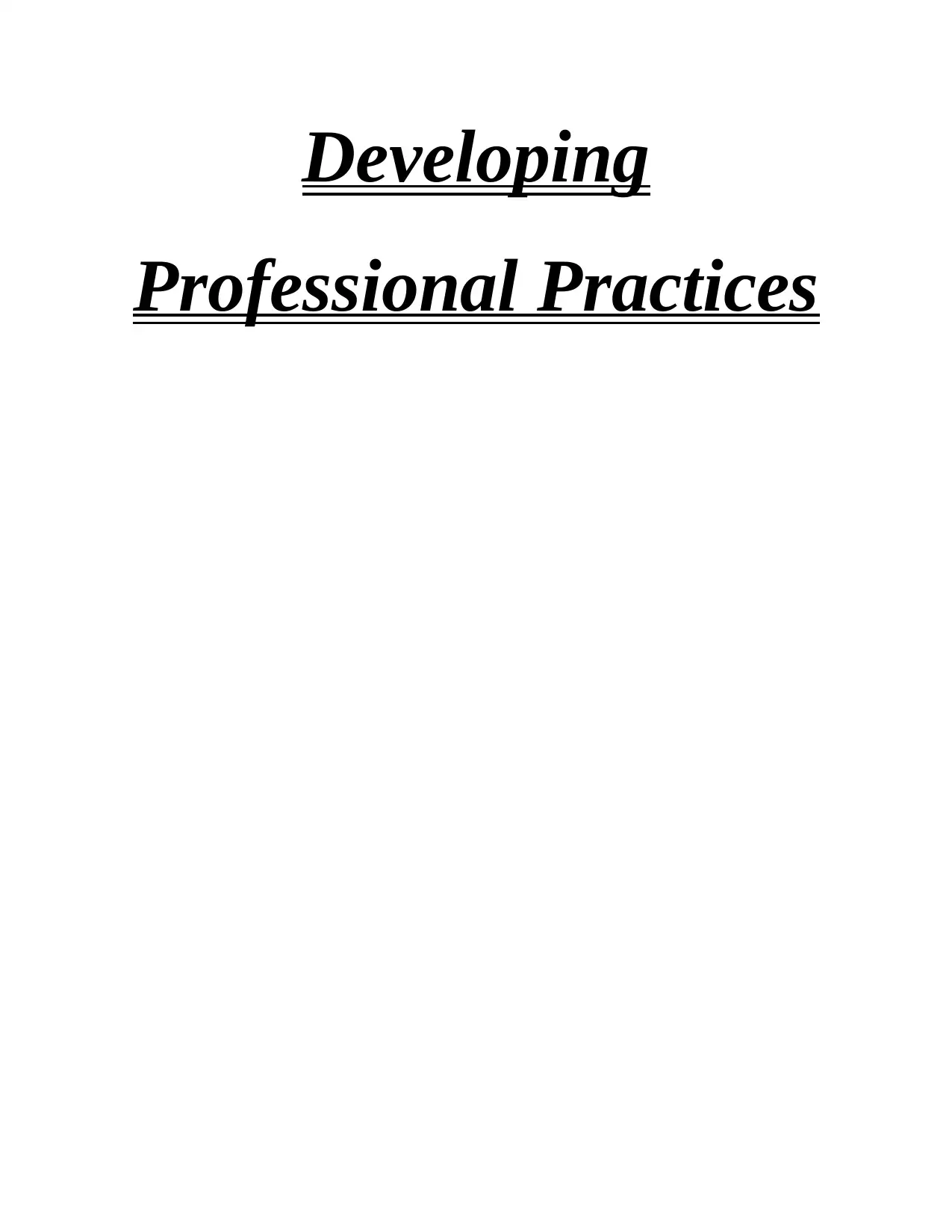
Developing
Professional Practices
Professional Practices
Paraphrase This Document
Need a fresh take? Get an instant paraphrase of this document with our AI Paraphraser
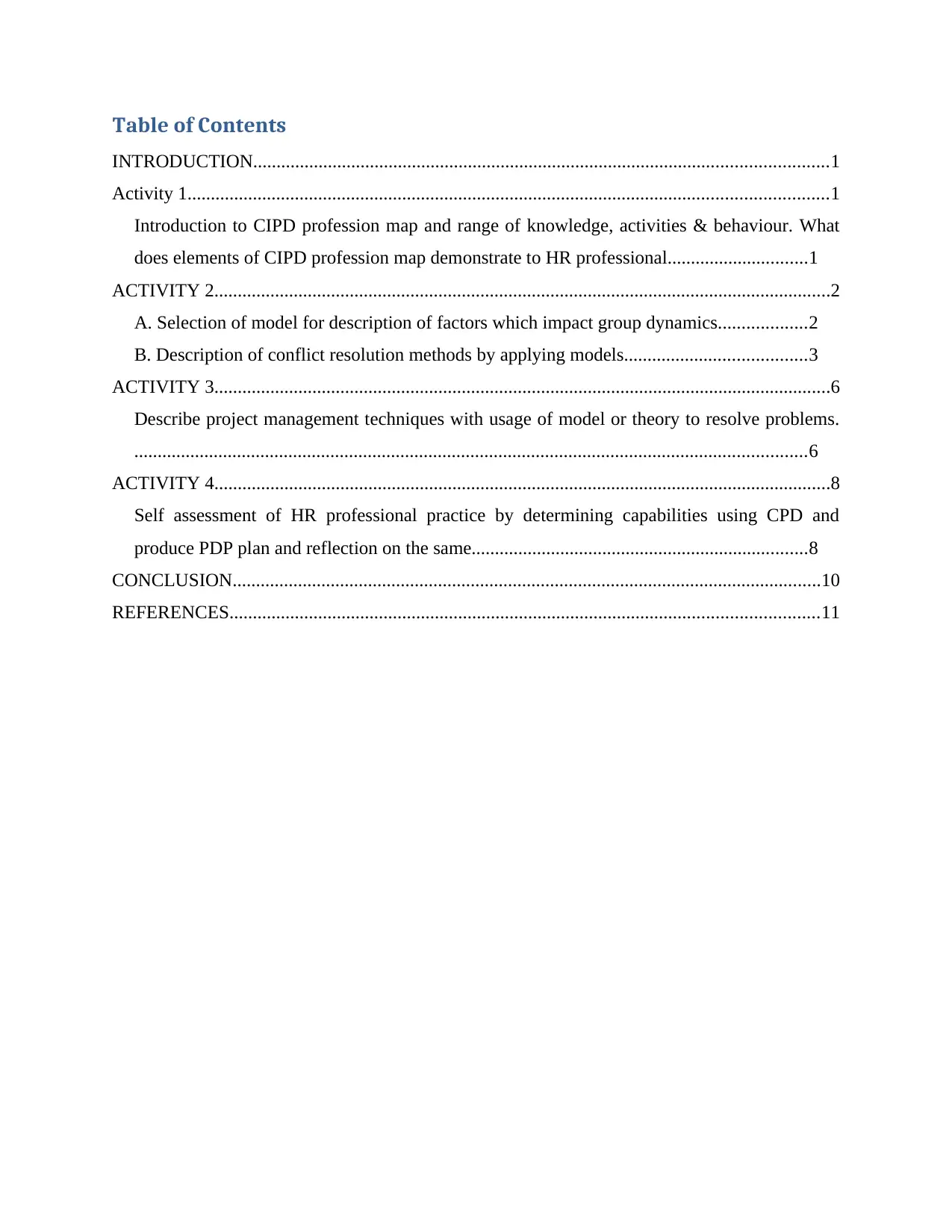
Table of Contents
INTRODUCTION...........................................................................................................................1
Activity 1.........................................................................................................................................1
Introduction to CIPD profession map and range of knowledge, activities & behaviour. What
does elements of CIPD profession map demonstrate to HR professional..............................1
ACTIVITY 2....................................................................................................................................2
A. Selection of model for description of factors which impact group dynamics...................2
B. Description of conflict resolution methods by applying models.......................................3
ACTIVITY 3....................................................................................................................................6
Describe project management techniques with usage of model or theory to resolve problems.
................................................................................................................................................6
ACTIVITY 4....................................................................................................................................8
Self assessment of HR professional practice by determining capabilities using CPD and
produce PDP plan and reflection on the same........................................................................8
CONCLUSION..............................................................................................................................10
REFERENCES..............................................................................................................................11
INTRODUCTION...........................................................................................................................1
Activity 1.........................................................................................................................................1
Introduction to CIPD profession map and range of knowledge, activities & behaviour. What
does elements of CIPD profession map demonstrate to HR professional..............................1
ACTIVITY 2....................................................................................................................................2
A. Selection of model for description of factors which impact group dynamics...................2
B. Description of conflict resolution methods by applying models.......................................3
ACTIVITY 3....................................................................................................................................6
Describe project management techniques with usage of model or theory to resolve problems.
................................................................................................................................................6
ACTIVITY 4....................................................................................................................................8
Self assessment of HR professional practice by determining capabilities using CPD and
produce PDP plan and reflection on the same........................................................................8
CONCLUSION..............................................................................................................................10
REFERENCES..............................................................................................................................11

⊘ This is a preview!⊘
Do you want full access?
Subscribe today to unlock all pages.

Trusted by 1+ million students worldwide
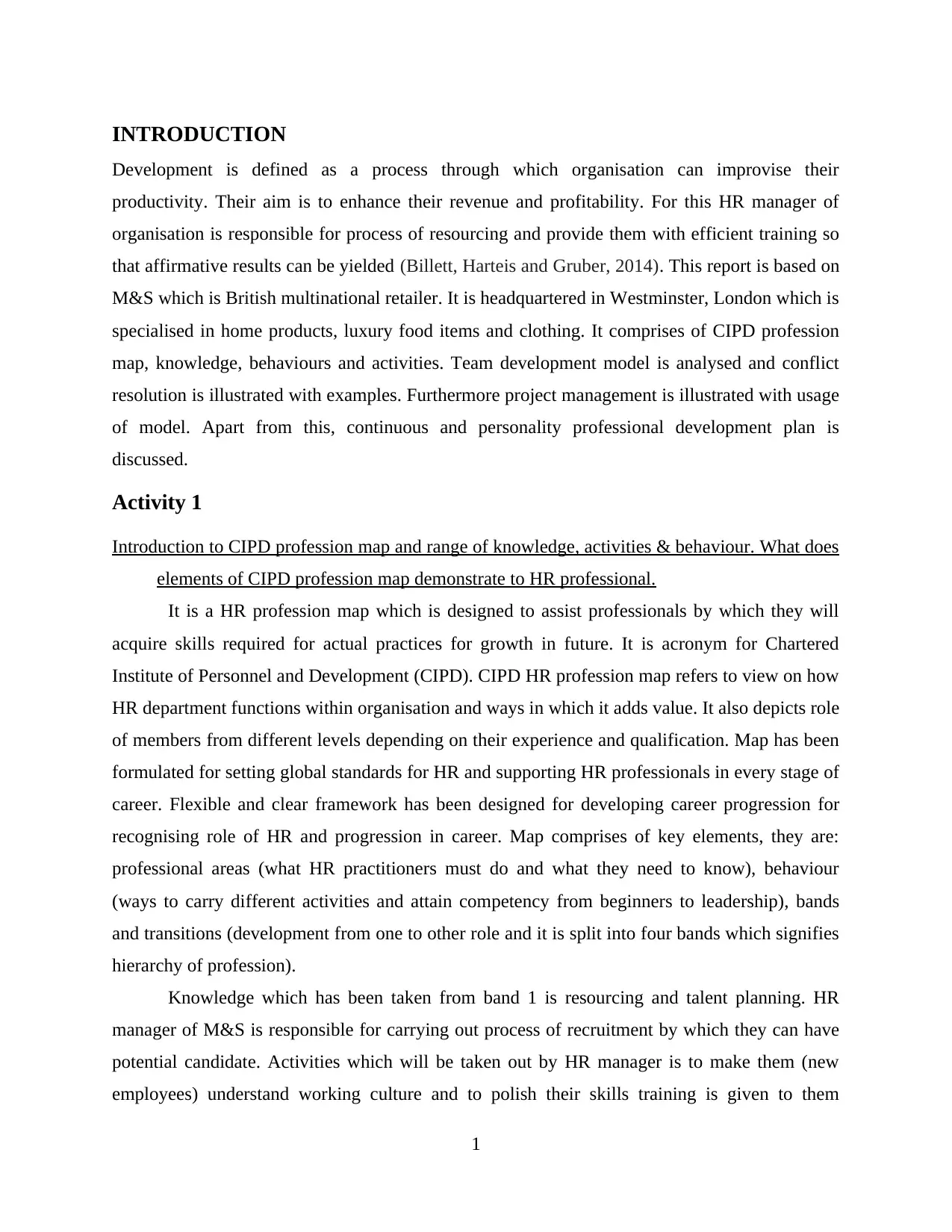
INTRODUCTION
Development is defined as a process through which organisation can improvise their
productivity. Their aim is to enhance their revenue and profitability. For this HR manager of
organisation is responsible for process of resourcing and provide them with efficient training so
that affirmative results can be yielded (Billett, Harteis and Gruber, 2014). This report is based on
M&S which is British multinational retailer. It is headquartered in Westminster, London which is
specialised in home products, luxury food items and clothing. It comprises of CIPD profession
map, knowledge, behaviours and activities. Team development model is analysed and conflict
resolution is illustrated with examples. Furthermore project management is illustrated with usage
of model. Apart from this, continuous and personality professional development plan is
discussed.
Activity 1
Introduction to CIPD profession map and range of knowledge, activities & behaviour. What does
elements of CIPD profession map demonstrate to HR professional.
It is a HR profession map which is designed to assist professionals by which they will
acquire skills required for actual practices for growth in future. It is acronym for Chartered
Institute of Personnel and Development (CIPD). CIPD HR profession map refers to view on how
HR department functions within organisation and ways in which it adds value. It also depicts role
of members from different levels depending on their experience and qualification. Map has been
formulated for setting global standards for HR and supporting HR professionals in every stage of
career. Flexible and clear framework has been designed for developing career progression for
recognising role of HR and progression in career. Map comprises of key elements, they are:
professional areas (what HR practitioners must do and what they need to know), behaviour
(ways to carry different activities and attain competency from beginners to leadership), bands
and transitions (development from one to other role and it is split into four bands which signifies
hierarchy of profession).
Knowledge which has been taken from band 1 is resourcing and talent planning. HR
manager of M&S is responsible for carrying out process of recruitment by which they can have
potential candidate. Activities which will be taken out by HR manager is to make them (new
employees) understand working culture and to polish their skills training is given to them
1
Development is defined as a process through which organisation can improvise their
productivity. Their aim is to enhance their revenue and profitability. For this HR manager of
organisation is responsible for process of resourcing and provide them with efficient training so
that affirmative results can be yielded (Billett, Harteis and Gruber, 2014). This report is based on
M&S which is British multinational retailer. It is headquartered in Westminster, London which is
specialised in home products, luxury food items and clothing. It comprises of CIPD profession
map, knowledge, behaviours and activities. Team development model is analysed and conflict
resolution is illustrated with examples. Furthermore project management is illustrated with usage
of model. Apart from this, continuous and personality professional development plan is
discussed.
Activity 1
Introduction to CIPD profession map and range of knowledge, activities & behaviour. What does
elements of CIPD profession map demonstrate to HR professional.
It is a HR profession map which is designed to assist professionals by which they will
acquire skills required for actual practices for growth in future. It is acronym for Chartered
Institute of Personnel and Development (CIPD). CIPD HR profession map refers to view on how
HR department functions within organisation and ways in which it adds value. It also depicts role
of members from different levels depending on their experience and qualification. Map has been
formulated for setting global standards for HR and supporting HR professionals in every stage of
career. Flexible and clear framework has been designed for developing career progression for
recognising role of HR and progression in career. Map comprises of key elements, they are:
professional areas (what HR practitioners must do and what they need to know), behaviour
(ways to carry different activities and attain competency from beginners to leadership), bands
and transitions (development from one to other role and it is split into four bands which signifies
hierarchy of profession).
Knowledge which has been taken from band 1 is resourcing and talent planning. HR
manager of M&S is responsible for carrying out process of recruitment by which they can have
potential candidate. Activities which will be taken out by HR manager is to make them (new
employees) understand working culture and to polish their skills training is given to them
1
Paraphrase This Document
Need a fresh take? Get an instant paraphrase of this document with our AI Paraphraser
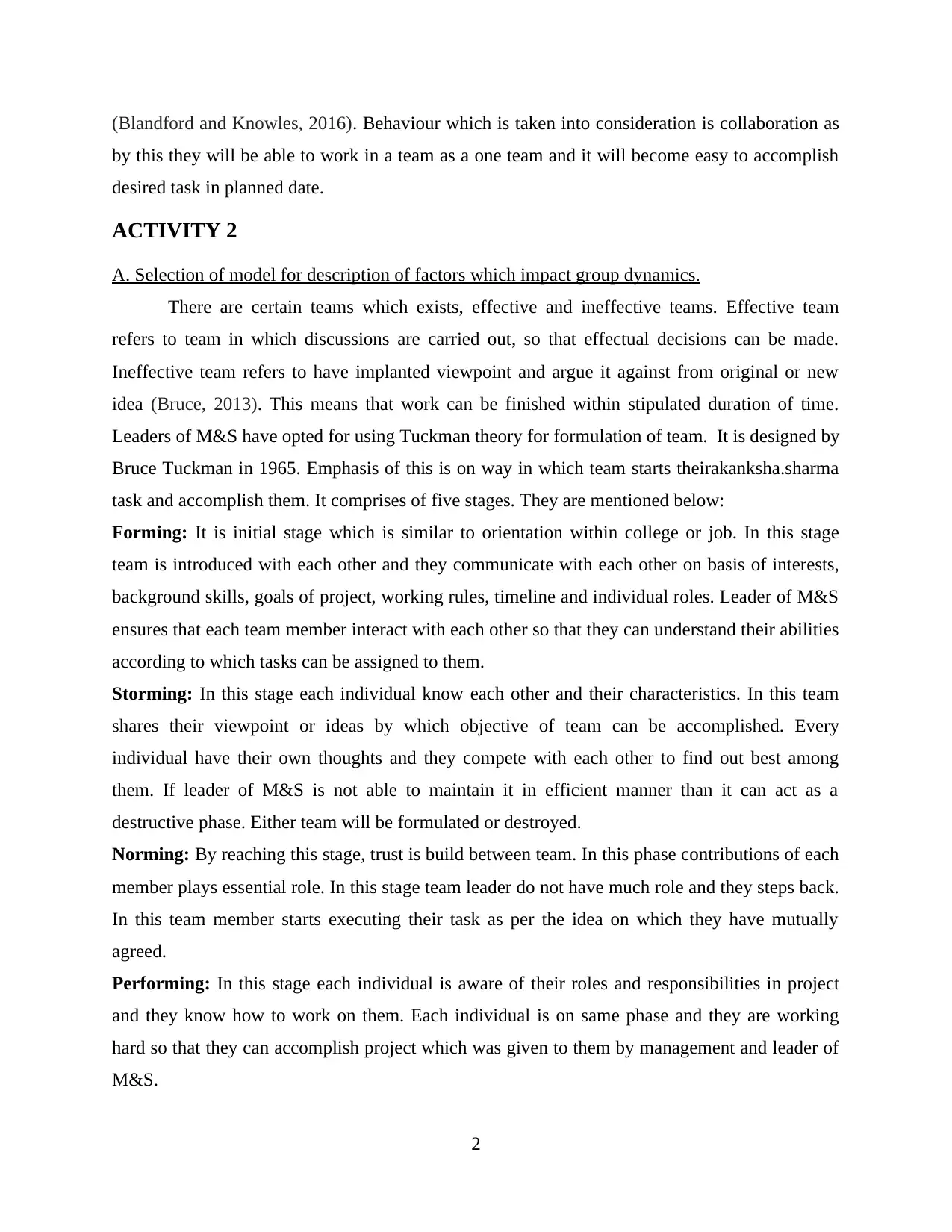
(Blandford and Knowles, 2016). Behaviour which is taken into consideration is collaboration as
by this they will be able to work in a team as a one team and it will become easy to accomplish
desired task in planned date.
ACTIVITY 2
A. Selection of model for description of factors which impact group dynamics.
There are certain teams which exists, effective and ineffective teams. Effective team
refers to team in which discussions are carried out, so that effectual decisions can be made.
Ineffective team refers to have implanted viewpoint and argue it against from original or new
idea (Bruce, 2013). This means that work can be finished within stipulated duration of time.
Leaders of M&S have opted for using Tuckman theory for formulation of team. It is designed by
Bruce Tuckman in 1965. Emphasis of this is on way in which team starts theirakanksha.sharma
task and accomplish them. It comprises of five stages. They are mentioned below:
Forming: It is initial stage which is similar to orientation within college or job. In this stage
team is introduced with each other and they communicate with each other on basis of interests,
background skills, goals of project, working rules, timeline and individual roles. Leader of M&S
ensures that each team member interact with each other so that they can understand their abilities
according to which tasks can be assigned to them.
Storming: In this stage each individual know each other and their characteristics. In this team
shares their viewpoint or ideas by which objective of team can be accomplished. Every
individual have their own thoughts and they compete with each other to find out best among
them. If leader of M&S is not able to maintain it in efficient manner than it can act as a
destructive phase. Either team will be formulated or destroyed.
Norming: By reaching this stage, trust is build between team. In this phase contributions of each
member plays essential role. In this stage team leader do not have much role and they steps back.
In this team member starts executing their task as per the idea on which they have mutually
agreed.
Performing: In this stage each individual is aware of their roles and responsibilities in project
and they know how to work on them. Each individual is on same phase and they are working
hard so that they can accomplish project which was given to them by management and leader of
M&S.
2
by this they will be able to work in a team as a one team and it will become easy to accomplish
desired task in planned date.
ACTIVITY 2
A. Selection of model for description of factors which impact group dynamics.
There are certain teams which exists, effective and ineffective teams. Effective team
refers to team in which discussions are carried out, so that effectual decisions can be made.
Ineffective team refers to have implanted viewpoint and argue it against from original or new
idea (Bruce, 2013). This means that work can be finished within stipulated duration of time.
Leaders of M&S have opted for using Tuckman theory for formulation of team. It is designed by
Bruce Tuckman in 1965. Emphasis of this is on way in which team starts theirakanksha.sharma
task and accomplish them. It comprises of five stages. They are mentioned below:
Forming: It is initial stage which is similar to orientation within college or job. In this stage
team is introduced with each other and they communicate with each other on basis of interests,
background skills, goals of project, working rules, timeline and individual roles. Leader of M&S
ensures that each team member interact with each other so that they can understand their abilities
according to which tasks can be assigned to them.
Storming: In this stage each individual know each other and their characteristics. In this team
shares their viewpoint or ideas by which objective of team can be accomplished. Every
individual have their own thoughts and they compete with each other to find out best among
them. If leader of M&S is not able to maintain it in efficient manner than it can act as a
destructive phase. Either team will be formulated or destroyed.
Norming: By reaching this stage, trust is build between team. In this phase contributions of each
member plays essential role. In this stage team leader do not have much role and they steps back.
In this team member starts executing their task as per the idea on which they have mutually
agreed.
Performing: In this stage each individual is aware of their roles and responsibilities in project
and they know how to work on them. Each individual is on same phase and they are working
hard so that they can accomplish project which was given to them by management and leader of
M&S.
2
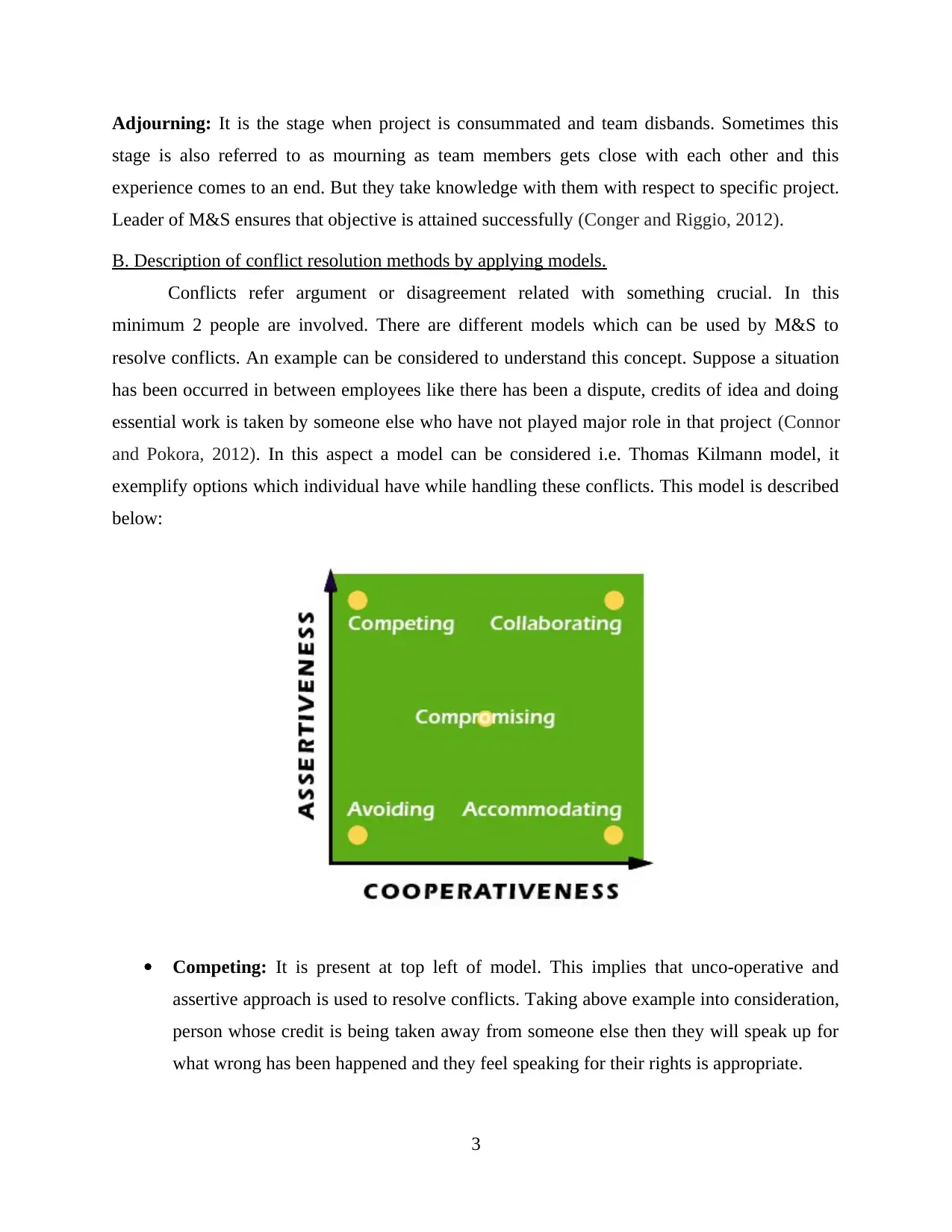
Adjourning: It is the stage when project is consummated and team disbands. Sometimes this
stage is also referred to as mourning as team members gets close with each other and this
experience comes to an end. But they take knowledge with them with respect to specific project.
Leader of M&S ensures that objective is attained successfully (Conger and Riggio, 2012).
B. Description of conflict resolution methods by applying models.
Conflicts refer argument or disagreement related with something crucial. In this
minimum 2 people are involved. There are different models which can be used by M&S to
resolve conflicts. An example can be considered to understand this concept. Suppose a situation
has been occurred in between employees like there has been a dispute, credits of idea and doing
essential work is taken by someone else who have not played major role in that project (Connor
and Pokora, 2012). In this aspect a model can be considered i.e. Thomas Kilmann model, it
exemplify options which individual have while handling these conflicts. This model is described
below:
Competing: It is present at top left of model. This implies that unco-operative and
assertive approach is used to resolve conflicts. Taking above example into consideration,
person whose credit is being taken away from someone else then they will speak up for
what wrong has been happened and they feel speaking for their rights is appropriate.
3
stage is also referred to as mourning as team members gets close with each other and this
experience comes to an end. But they take knowledge with them with respect to specific project.
Leader of M&S ensures that objective is attained successfully (Conger and Riggio, 2012).
B. Description of conflict resolution methods by applying models.
Conflicts refer argument or disagreement related with something crucial. In this
minimum 2 people are involved. There are different models which can be used by M&S to
resolve conflicts. An example can be considered to understand this concept. Suppose a situation
has been occurred in between employees like there has been a dispute, credits of idea and doing
essential work is taken by someone else who have not played major role in that project (Connor
and Pokora, 2012). In this aspect a model can be considered i.e. Thomas Kilmann model, it
exemplify options which individual have while handling these conflicts. This model is described
below:
Competing: It is present at top left of model. This implies that unco-operative and
assertive approach is used to resolve conflicts. Taking above example into consideration,
person whose credit is being taken away from someone else then they will speak up for
what wrong has been happened and they feel speaking for their rights is appropriate.
3
⊘ This is a preview!⊘
Do you want full access?
Subscribe today to unlock all pages.

Trusted by 1+ million students worldwide
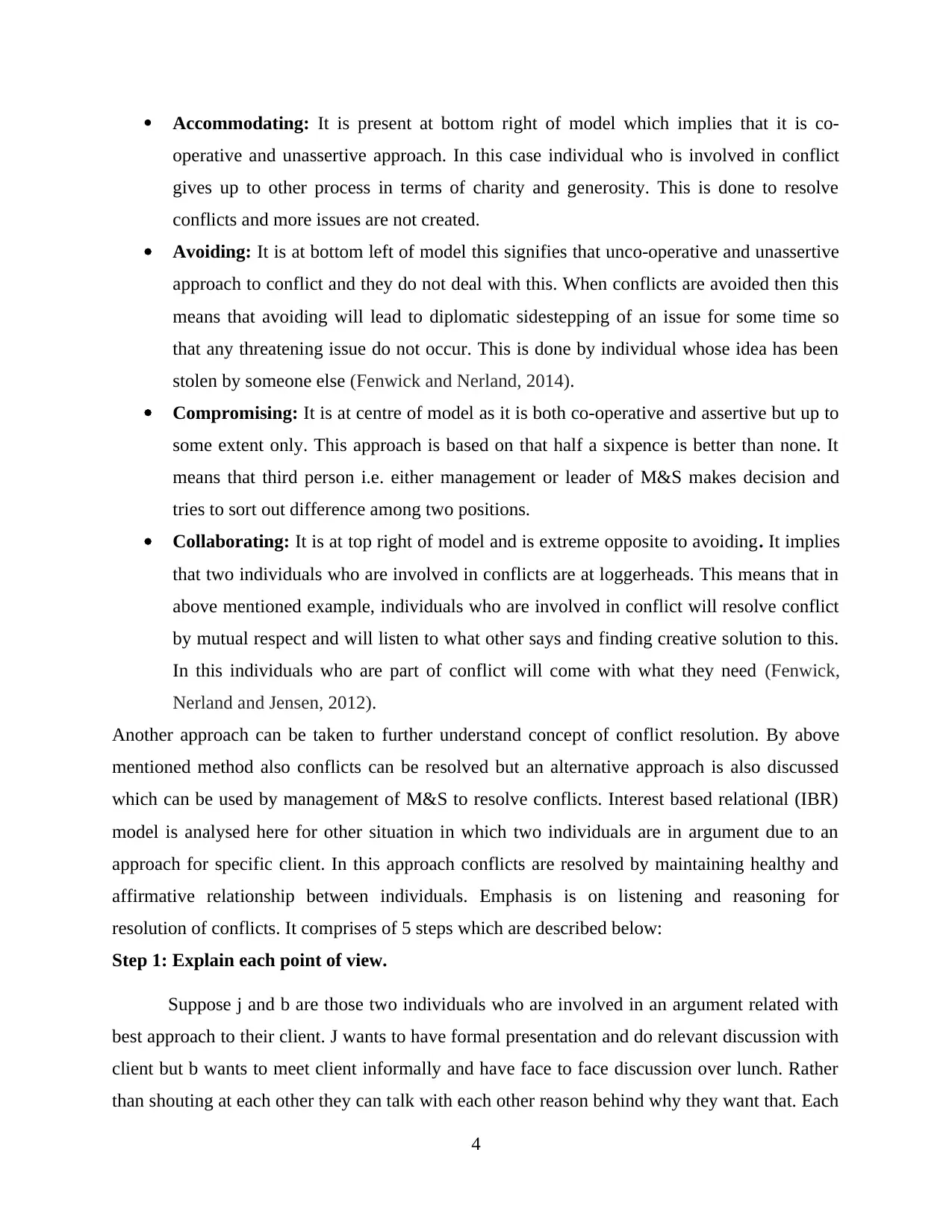
Accommodating: It is present at bottom right of model which implies that it is co-
operative and unassertive approach. In this case individual who is involved in conflict
gives up to other process in terms of charity and generosity. This is done to resolve
conflicts and more issues are not created.
Avoiding: It is at bottom left of model this signifies that unco-operative and unassertive
approach to conflict and they do not deal with this. When conflicts are avoided then this
means that avoiding will lead to diplomatic sidestepping of an issue for some time so
that any threatening issue do not occur. This is done by individual whose idea has been
stolen by someone else (Fenwick and Nerland, 2014).
Compromising: It is at centre of model as it is both co-operative and assertive but up to
some extent only. This approach is based on that half a sixpence is better than none. It
means that third person i.e. either management or leader of M&S makes decision and
tries to sort out difference among two positions.
Collaborating: It is at top right of model and is extreme opposite to avoiding. It implies
that two individuals who are involved in conflicts are at loggerheads. This means that in
above mentioned example, individuals who are involved in conflict will resolve conflict
by mutual respect and will listen to what other says and finding creative solution to this.
In this individuals who are part of conflict will come with what they need (Fenwick,
Nerland and Jensen, 2012).
Another approach can be taken to further understand concept of conflict resolution. By above
mentioned method also conflicts can be resolved but an alternative approach is also discussed
which can be used by management of M&S to resolve conflicts. Interest based relational (IBR)
model is analysed here for other situation in which two individuals are in argument due to an
approach for specific client. In this approach conflicts are resolved by maintaining healthy and
affirmative relationship between individuals. Emphasis is on listening and reasoning for
resolution of conflicts. It comprises of 5 steps which are described below:
Step 1: Explain each point of view.
Suppose j and b are those two individuals who are involved in an argument related with
best approach to their client. J wants to have formal presentation and do relevant discussion with
client but b wants to meet client informally and have face to face discussion over lunch. Rather
than shouting at each other they can talk with each other reason behind why they want that. Each
4
operative and unassertive approach. In this case individual who is involved in conflict
gives up to other process in terms of charity and generosity. This is done to resolve
conflicts and more issues are not created.
Avoiding: It is at bottom left of model this signifies that unco-operative and unassertive
approach to conflict and they do not deal with this. When conflicts are avoided then this
means that avoiding will lead to diplomatic sidestepping of an issue for some time so
that any threatening issue do not occur. This is done by individual whose idea has been
stolen by someone else (Fenwick and Nerland, 2014).
Compromising: It is at centre of model as it is both co-operative and assertive but up to
some extent only. This approach is based on that half a sixpence is better than none. It
means that third person i.e. either management or leader of M&S makes decision and
tries to sort out difference among two positions.
Collaborating: It is at top right of model and is extreme opposite to avoiding. It implies
that two individuals who are involved in conflicts are at loggerheads. This means that in
above mentioned example, individuals who are involved in conflict will resolve conflict
by mutual respect and will listen to what other says and finding creative solution to this.
In this individuals who are part of conflict will come with what they need (Fenwick,
Nerland and Jensen, 2012).
Another approach can be taken to further understand concept of conflict resolution. By above
mentioned method also conflicts can be resolved but an alternative approach is also discussed
which can be used by management of M&S to resolve conflicts. Interest based relational (IBR)
model is analysed here for other situation in which two individuals are in argument due to an
approach for specific client. In this approach conflicts are resolved by maintaining healthy and
affirmative relationship between individuals. Emphasis is on listening and reasoning for
resolution of conflicts. It comprises of 5 steps which are described below:
Step 1: Explain each point of view.
Suppose j and b are those two individuals who are involved in an argument related with
best approach to their client. J wants to have formal presentation and do relevant discussion with
client but b wants to meet client informally and have face to face discussion over lunch. Rather
than shouting at each other they can talk with each other reason behind why they want that. Each
4
Paraphrase This Document
Need a fresh take? Get an instant paraphrase of this document with our AI Paraphraser
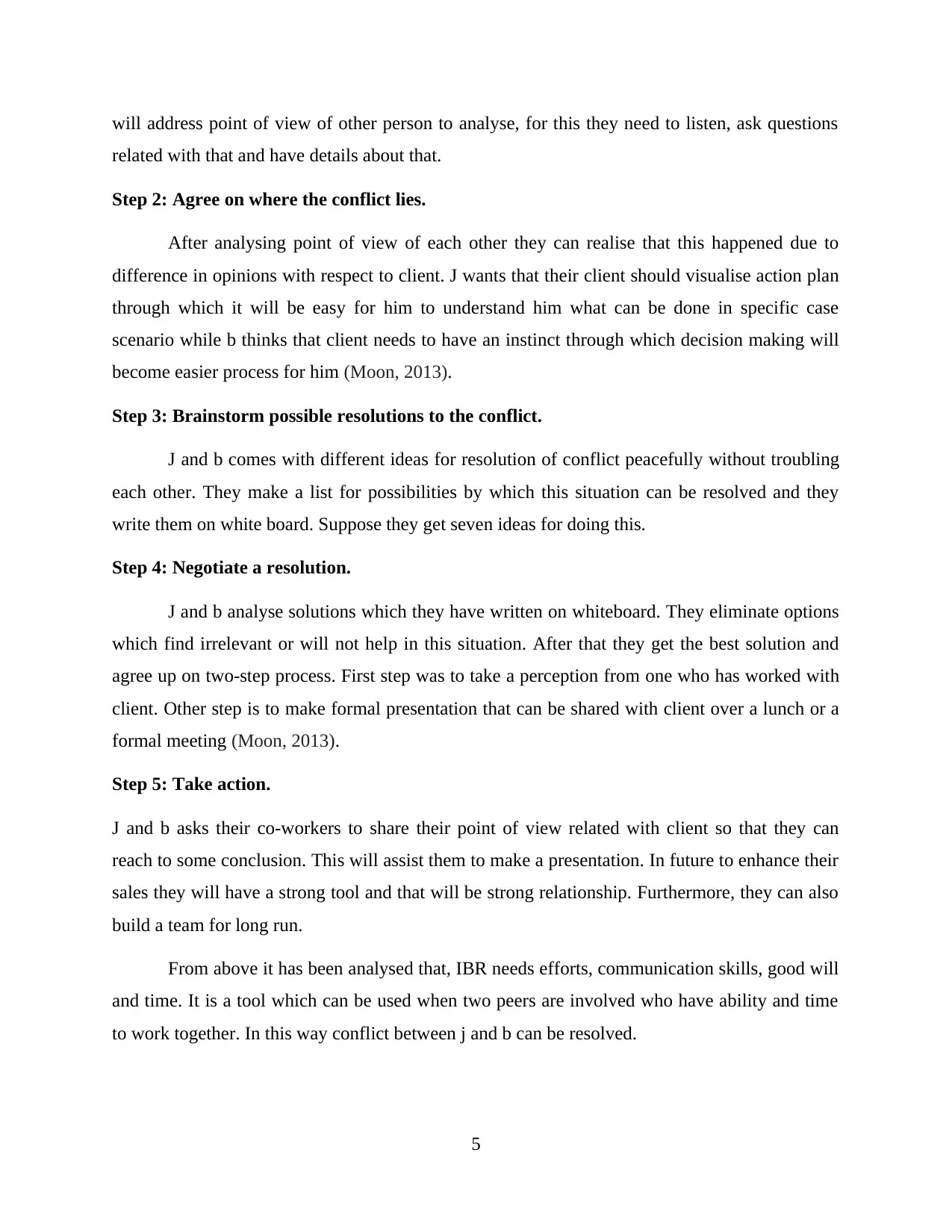
will address point of view of other person to analyse, for this they need to listen, ask questions
related with that and have details about that.
Step 2: Agree on where the conflict lies.
After analysing point of view of each other they can realise that this happened due to
difference in opinions with respect to client. J wants that their client should visualise action plan
through which it will be easy for him to understand him what can be done in specific case
scenario while b thinks that client needs to have an instinct through which decision making will
become easier process for him (Moon, 2013).
Step 3: Brainstorm possible resolutions to the conflict.
J and b comes with different ideas for resolution of conflict peacefully without troubling
each other. They make a list for possibilities by which this situation can be resolved and they
write them on white board. Suppose they get seven ideas for doing this.
Step 4: Negotiate a resolution.
J and b analyse solutions which they have written on whiteboard. They eliminate options
which find irrelevant or will not help in this situation. After that they get the best solution and
agree up on two-step process. First step was to take a perception from one who has worked with
client. Other step is to make formal presentation that can be shared with client over a lunch or a
formal meeting (Moon, 2013).
Step 5: Take action.
J and b asks their co-workers to share their point of view related with client so that they can
reach to some conclusion. This will assist them to make a presentation. In future to enhance their
sales they will have a strong tool and that will be strong relationship. Furthermore, they can also
build a team for long run.
From above it has been analysed that, IBR needs efforts, communication skills, good will
and time. It is a tool which can be used when two peers are involved who have ability and time
to work together. In this way conflict between j and b can be resolved.
5
related with that and have details about that.
Step 2: Agree on where the conflict lies.
After analysing point of view of each other they can realise that this happened due to
difference in opinions with respect to client. J wants that their client should visualise action plan
through which it will be easy for him to understand him what can be done in specific case
scenario while b thinks that client needs to have an instinct through which decision making will
become easier process for him (Moon, 2013).
Step 3: Brainstorm possible resolutions to the conflict.
J and b comes with different ideas for resolution of conflict peacefully without troubling
each other. They make a list for possibilities by which this situation can be resolved and they
write them on white board. Suppose they get seven ideas for doing this.
Step 4: Negotiate a resolution.
J and b analyse solutions which they have written on whiteboard. They eliminate options
which find irrelevant or will not help in this situation. After that they get the best solution and
agree up on two-step process. First step was to take a perception from one who has worked with
client. Other step is to make formal presentation that can be shared with client over a lunch or a
formal meeting (Moon, 2013).
Step 5: Take action.
J and b asks their co-workers to share their point of view related with client so that they can
reach to some conclusion. This will assist them to make a presentation. In future to enhance their
sales they will have a strong tool and that will be strong relationship. Furthermore, they can also
build a team for long run.
From above it has been analysed that, IBR needs efforts, communication skills, good will
and time. It is a tool which can be used when two peers are involved who have ability and time
to work together. In this way conflict between j and b can be resolved.
5
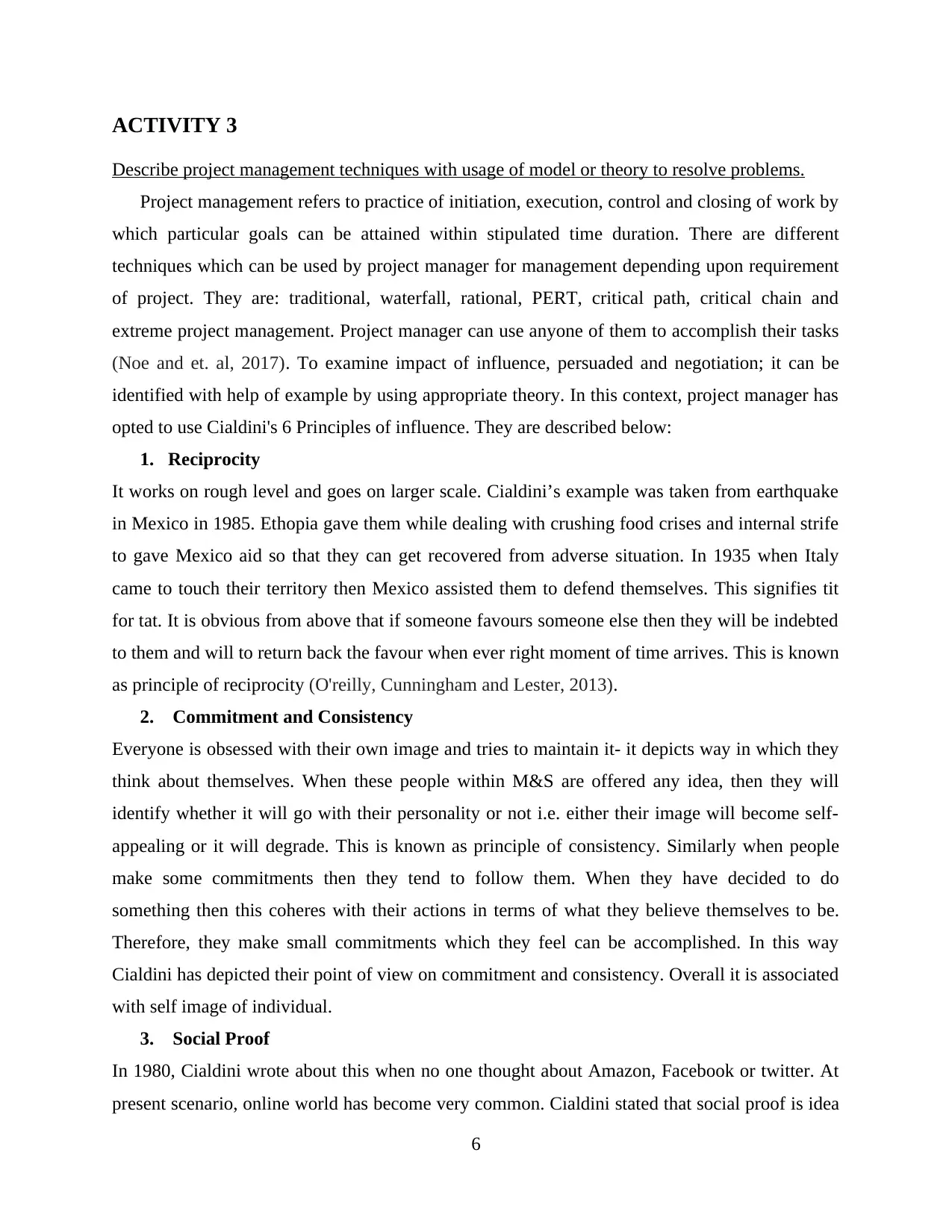
ACTIVITY 3
Describe project management techniques with usage of model or theory to resolve problems.
Project management refers to practice of initiation, execution, control and closing of work by
which particular goals can be attained within stipulated time duration. There are different
techniques which can be used by project manager for management depending upon requirement
of project. They are: traditional, waterfall, rational, PERT, critical path, critical chain and
extreme project management. Project manager can use anyone of them to accomplish their tasks
(Noe and et. al, 2017). To examine impact of influence, persuaded and negotiation; it can be
identified with help of example by using appropriate theory. In this context, project manager has
opted to use Cialdini's 6 Principles of influence. They are described below:
1. Reciprocity
It works on rough level and goes on larger scale. Cialdini’s example was taken from earthquake
in Mexico in 1985. Ethopia gave them while dealing with crushing food crises and internal strife
to gave Mexico aid so that they can get recovered from adverse situation. In 1935 when Italy
came to touch their territory then Mexico assisted them to defend themselves. This signifies tit
for tat. It is obvious from above that if someone favours someone else then they will be indebted
to them and will to return back the favour when ever right moment of time arrives. This is known
as principle of reciprocity (O'reilly, Cunningham and Lester, 2013).
2. Commitment and Consistency
Everyone is obsessed with their own image and tries to maintain it- it depicts way in which they
think about themselves. When these people within M&S are offered any idea, then they will
identify whether it will go with their personality or not i.e. either their image will become self-
appealing or it will degrade. This is known as principle of consistency. Similarly when people
make some commitments then they tend to follow them. When they have decided to do
something then this coheres with their actions in terms of what they believe themselves to be.
Therefore, they make small commitments which they feel can be accomplished. In this way
Cialdini has depicted their point of view on commitment and consistency. Overall it is associated
with self image of individual.
3. Social Proof
In 1980, Cialdini wrote about this when no one thought about Amazon, Facebook or twitter. At
present scenario, online world has become very common. Cialdini stated that social proof is idea
6
Describe project management techniques with usage of model or theory to resolve problems.
Project management refers to practice of initiation, execution, control and closing of work by
which particular goals can be attained within stipulated time duration. There are different
techniques which can be used by project manager for management depending upon requirement
of project. They are: traditional, waterfall, rational, PERT, critical path, critical chain and
extreme project management. Project manager can use anyone of them to accomplish their tasks
(Noe and et. al, 2017). To examine impact of influence, persuaded and negotiation; it can be
identified with help of example by using appropriate theory. In this context, project manager has
opted to use Cialdini's 6 Principles of influence. They are described below:
1. Reciprocity
It works on rough level and goes on larger scale. Cialdini’s example was taken from earthquake
in Mexico in 1985. Ethopia gave them while dealing with crushing food crises and internal strife
to gave Mexico aid so that they can get recovered from adverse situation. In 1935 when Italy
came to touch their territory then Mexico assisted them to defend themselves. This signifies tit
for tat. It is obvious from above that if someone favours someone else then they will be indebted
to them and will to return back the favour when ever right moment of time arrives. This is known
as principle of reciprocity (O'reilly, Cunningham and Lester, 2013).
2. Commitment and Consistency
Everyone is obsessed with their own image and tries to maintain it- it depicts way in which they
think about themselves. When these people within M&S are offered any idea, then they will
identify whether it will go with their personality or not i.e. either their image will become self-
appealing or it will degrade. This is known as principle of consistency. Similarly when people
make some commitments then they tend to follow them. When they have decided to do
something then this coheres with their actions in terms of what they believe themselves to be.
Therefore, they make small commitments which they feel can be accomplished. In this way
Cialdini has depicted their point of view on commitment and consistency. Overall it is associated
with self image of individual.
3. Social Proof
In 1980, Cialdini wrote about this when no one thought about Amazon, Facebook or twitter. At
present scenario, online world has become very common. Cialdini stated that social proof is idea
6
⊘ This is a preview!⊘
Do you want full access?
Subscribe today to unlock all pages.

Trusted by 1+ million students worldwide
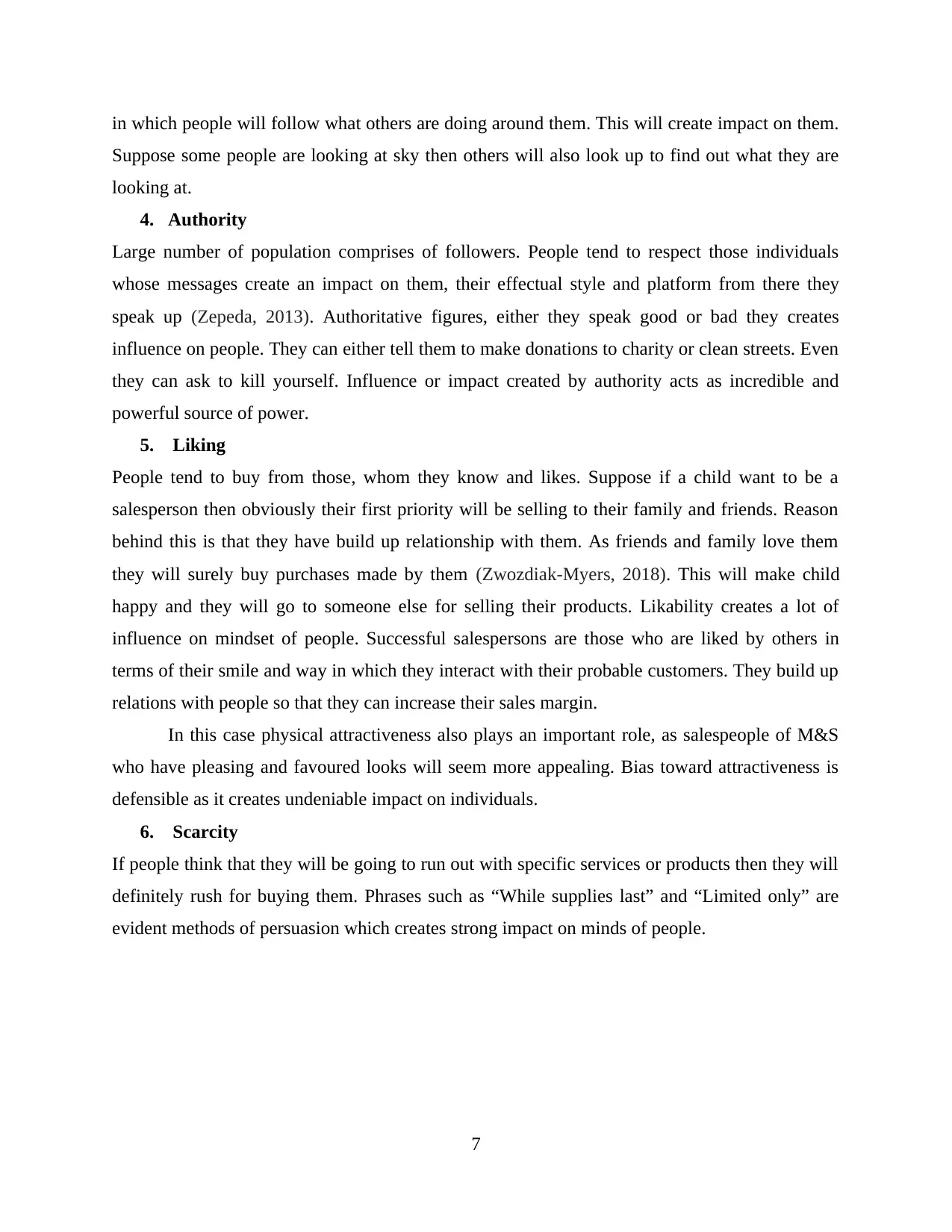
in which people will follow what others are doing around them. This will create impact on them.
Suppose some people are looking at sky then others will also look up to find out what they are
looking at.
4. Authority
Large number of population comprises of followers. People tend to respect those individuals
whose messages create an impact on them, their effectual style and platform from there they
speak up (Zepeda, 2013). Authoritative figures, either they speak good or bad they creates
influence on people. They can either tell them to make donations to charity or clean streets. Even
they can ask to kill yourself. Influence or impact created by authority acts as incredible and
powerful source of power.
5. Liking
People tend to buy from those, whom they know and likes. Suppose if a child want to be a
salesperson then obviously their first priority will be selling to their family and friends. Reason
behind this is that they have build up relationship with them. As friends and family love them
they will surely buy purchases made by them (Zwozdiak-Myers, 2018). This will make child
happy and they will go to someone else for selling their products. Likability creates a lot of
influence on mindset of people. Successful salespersons are those who are liked by others in
terms of their smile and way in which they interact with their probable customers. They build up
relations with people so that they can increase their sales margin.
In this case physical attractiveness also plays an important role, as salespeople of M&S
who have pleasing and favoured looks will seem more appealing. Bias toward attractiveness is
defensible as it creates undeniable impact on individuals.
6. Scarcity
If people think that they will be going to run out with specific services or products then they will
definitely rush for buying them. Phrases such as “While supplies last” and “Limited only” are
evident methods of persuasion which creates strong impact on minds of people.
7
Suppose some people are looking at sky then others will also look up to find out what they are
looking at.
4. Authority
Large number of population comprises of followers. People tend to respect those individuals
whose messages create an impact on them, their effectual style and platform from there they
speak up (Zepeda, 2013). Authoritative figures, either they speak good or bad they creates
influence on people. They can either tell them to make donations to charity or clean streets. Even
they can ask to kill yourself. Influence or impact created by authority acts as incredible and
powerful source of power.
5. Liking
People tend to buy from those, whom they know and likes. Suppose if a child want to be a
salesperson then obviously their first priority will be selling to their family and friends. Reason
behind this is that they have build up relationship with them. As friends and family love them
they will surely buy purchases made by them (Zwozdiak-Myers, 2018). This will make child
happy and they will go to someone else for selling their products. Likability creates a lot of
influence on mindset of people. Successful salespersons are those who are liked by others in
terms of their smile and way in which they interact with their probable customers. They build up
relations with people so that they can increase their sales margin.
In this case physical attractiveness also plays an important role, as salespeople of M&S
who have pleasing and favoured looks will seem more appealing. Bias toward attractiveness is
defensible as it creates undeniable impact on individuals.
6. Scarcity
If people think that they will be going to run out with specific services or products then they will
definitely rush for buying them. Phrases such as “While supplies last” and “Limited only” are
evident methods of persuasion which creates strong impact on minds of people.
7
Paraphrase This Document
Need a fresh take? Get an instant paraphrase of this document with our AI Paraphraser
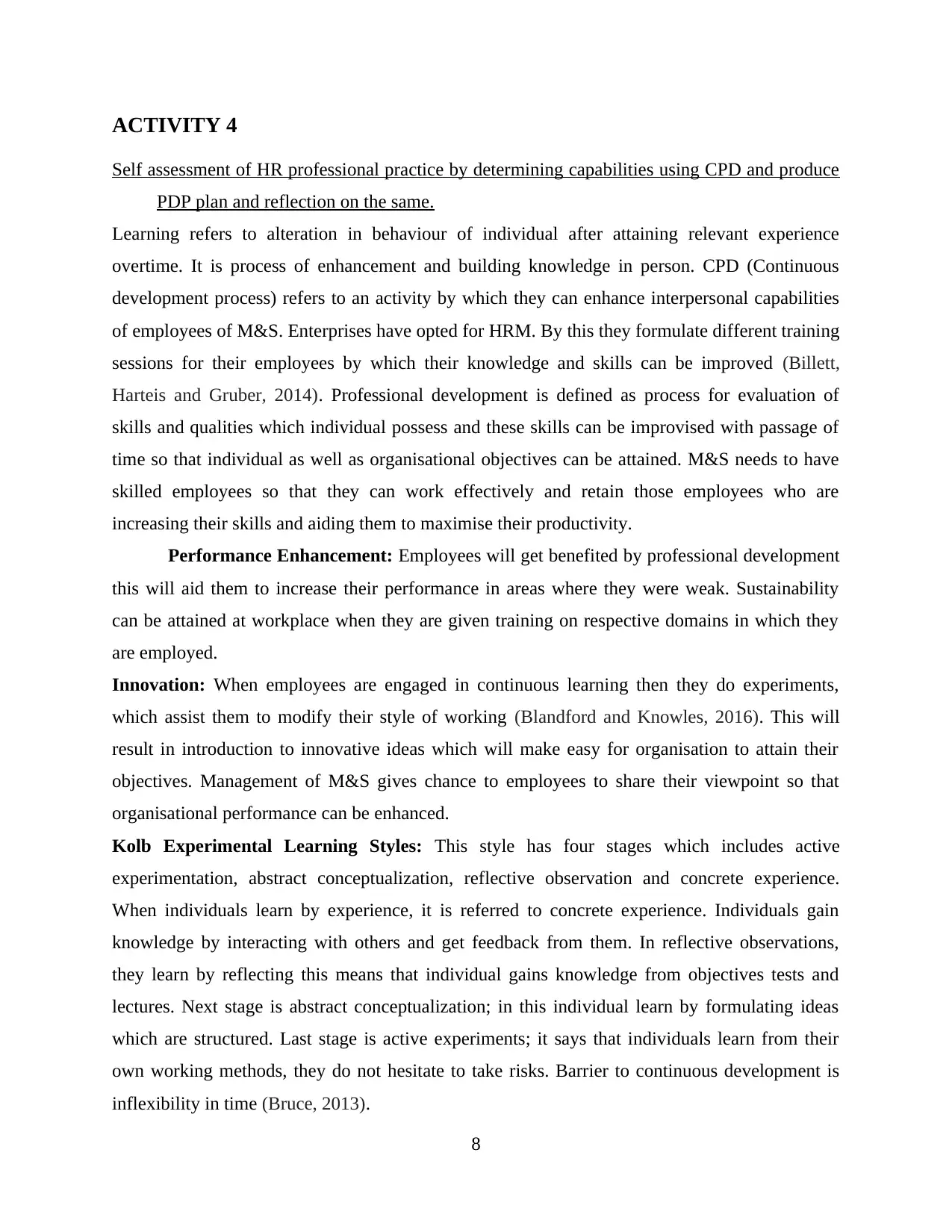
ACTIVITY 4
Self assessment of HR professional practice by determining capabilities using CPD and produce
PDP plan and reflection on the same.
Learning refers to alteration in behaviour of individual after attaining relevant experience
overtime. It is process of enhancement and building knowledge in person. CPD (Continuous
development process) refers to an activity by which they can enhance interpersonal capabilities
of employees of M&S. Enterprises have opted for HRM. By this they formulate different training
sessions for their employees by which their knowledge and skills can be improved (Billett,
Harteis and Gruber, 2014). Professional development is defined as process for evaluation of
skills and qualities which individual possess and these skills can be improvised with passage of
time so that individual as well as organisational objectives can be attained. M&S needs to have
skilled employees so that they can work effectively and retain those employees who are
increasing their skills and aiding them to maximise their productivity.
Performance Enhancement: Employees will get benefited by professional development
this will aid them to increase their performance in areas where they were weak. Sustainability
can be attained at workplace when they are given training on respective domains in which they
are employed.
Innovation: When employees are engaged in continuous learning then they do experiments,
which assist them to modify their style of working (Blandford and Knowles, 2016). This will
result in introduction to innovative ideas which will make easy for organisation to attain their
objectives. Management of M&S gives chance to employees to share their viewpoint so that
organisational performance can be enhanced.
Kolb Experimental Learning Styles: This style has four stages which includes active
experimentation, abstract conceptualization, reflective observation and concrete experience.
When individuals learn by experience, it is referred to concrete experience. Individuals gain
knowledge by interacting with others and get feedback from them. In reflective observations,
they learn by reflecting this means that individual gains knowledge from objectives tests and
lectures. Next stage is abstract conceptualization; in this individual learn by formulating ideas
which are structured. Last stage is active experiments; it says that individuals learn from their
own working methods, they do not hesitate to take risks. Barrier to continuous development is
inflexibility in time (Bruce, 2013).
8
Self assessment of HR professional practice by determining capabilities using CPD and produce
PDP plan and reflection on the same.
Learning refers to alteration in behaviour of individual after attaining relevant experience
overtime. It is process of enhancement and building knowledge in person. CPD (Continuous
development process) refers to an activity by which they can enhance interpersonal capabilities
of employees of M&S. Enterprises have opted for HRM. By this they formulate different training
sessions for their employees by which their knowledge and skills can be improved (Billett,
Harteis and Gruber, 2014). Professional development is defined as process for evaluation of
skills and qualities which individual possess and these skills can be improvised with passage of
time so that individual as well as organisational objectives can be attained. M&S needs to have
skilled employees so that they can work effectively and retain those employees who are
increasing their skills and aiding them to maximise their productivity.
Performance Enhancement: Employees will get benefited by professional development
this will aid them to increase their performance in areas where they were weak. Sustainability
can be attained at workplace when they are given training on respective domains in which they
are employed.
Innovation: When employees are engaged in continuous learning then they do experiments,
which assist them to modify their style of working (Blandford and Knowles, 2016). This will
result in introduction to innovative ideas which will make easy for organisation to attain their
objectives. Management of M&S gives chance to employees to share their viewpoint so that
organisational performance can be enhanced.
Kolb Experimental Learning Styles: This style has four stages which includes active
experimentation, abstract conceptualization, reflective observation and concrete experience.
When individuals learn by experience, it is referred to concrete experience. Individuals gain
knowledge by interacting with others and get feedback from them. In reflective observations,
they learn by reflecting this means that individual gains knowledge from objectives tests and
lectures. Next stage is abstract conceptualization; in this individual learn by formulating ideas
which are structured. Last stage is active experiments; it says that individuals learn from their
own working methods, they do not hesitate to take risks. Barrier to continuous development is
inflexibility in time (Bruce, 2013).
8
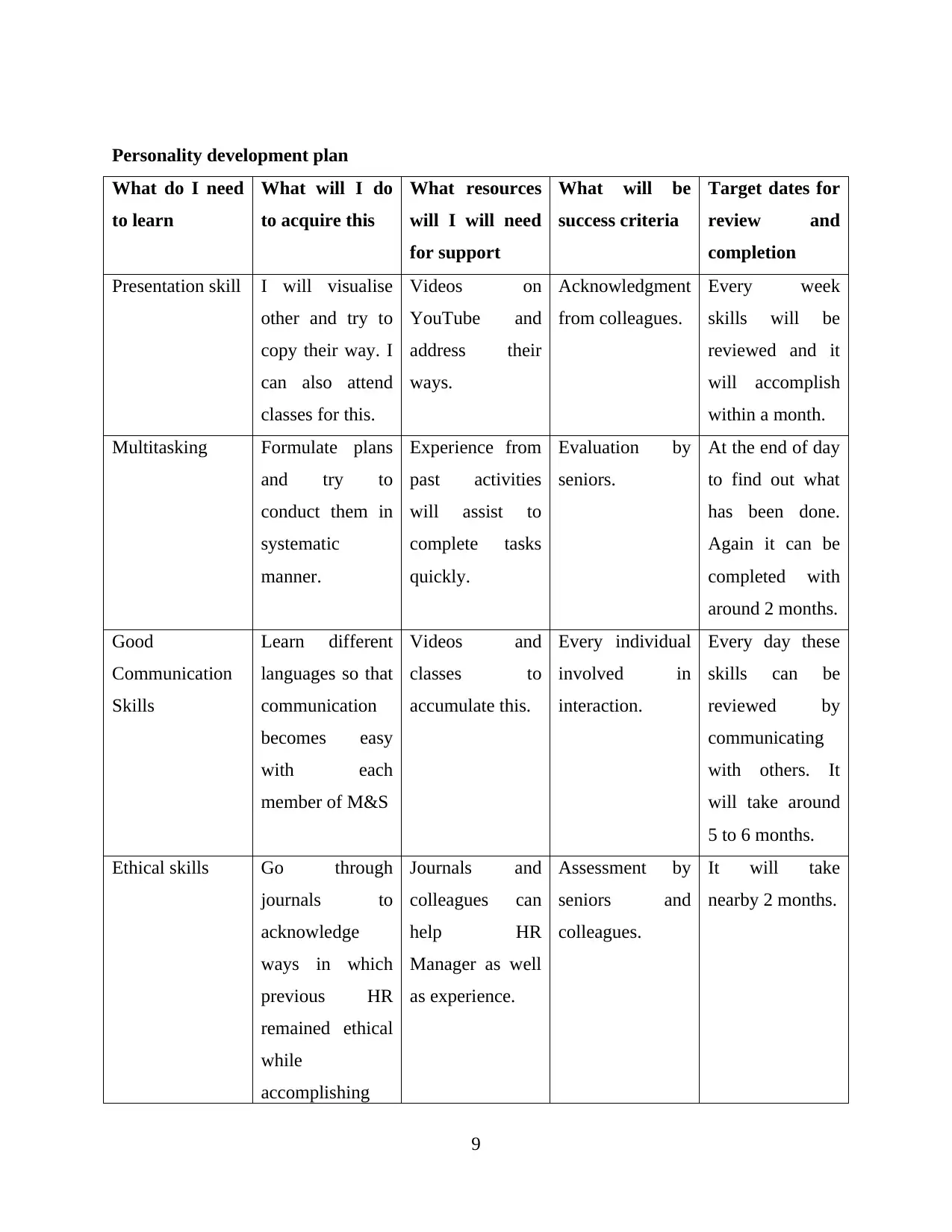
Personality development plan
What do I need
to learn
What will I do
to acquire this
What resources
will I will need
for support
What will be
success criteria
Target dates for
review and
completion
Presentation skill I will visualise
other and try to
copy their way. I
can also attend
classes for this.
Videos on
YouTube and
address their
ways.
Acknowledgment
from colleagues.
Every week
skills will be
reviewed and it
will accomplish
within a month.
Multitasking Formulate plans
and try to
conduct them in
systematic
manner.
Experience from
past activities
will assist to
complete tasks
quickly.
Evaluation by
seniors.
At the end of day
to find out what
has been done.
Again it can be
completed with
around 2 months.
Good
Communication
Skills
Learn different
languages so that
communication
becomes easy
with each
member of M&S
Videos and
classes to
accumulate this.
Every individual
involved in
interaction.
Every day these
skills can be
reviewed by
communicating
with others. It
will take around
5 to 6 months.
Ethical skills Go through
journals to
acknowledge
ways in which
previous HR
remained ethical
while
accomplishing
Journals and
colleagues can
help HR
Manager as well
as experience.
Assessment by
seniors and
colleagues.
It will take
nearby 2 months.
9
What do I need
to learn
What will I do
to acquire this
What resources
will I will need
for support
What will be
success criteria
Target dates for
review and
completion
Presentation skill I will visualise
other and try to
copy their way. I
can also attend
classes for this.
Videos on
YouTube and
address their
ways.
Acknowledgment
from colleagues.
Every week
skills will be
reviewed and it
will accomplish
within a month.
Multitasking Formulate plans
and try to
conduct them in
systematic
manner.
Experience from
past activities
will assist to
complete tasks
quickly.
Evaluation by
seniors.
At the end of day
to find out what
has been done.
Again it can be
completed with
around 2 months.
Good
Communication
Skills
Learn different
languages so that
communication
becomes easy
with each
member of M&S
Videos and
classes to
accumulate this.
Every individual
involved in
interaction.
Every day these
skills can be
reviewed by
communicating
with others. It
will take around
5 to 6 months.
Ethical skills Go through
journals to
acknowledge
ways in which
previous HR
remained ethical
while
accomplishing
Journals and
colleagues can
help HR
Manager as well
as experience.
Assessment by
seniors and
colleagues.
It will take
nearby 2 months.
9
⊘ This is a preview!⊘
Do you want full access?
Subscribe today to unlock all pages.

Trusted by 1+ million students worldwide
1 out of 14
Related Documents
Your All-in-One AI-Powered Toolkit for Academic Success.
+13062052269
info@desklib.com
Available 24*7 on WhatsApp / Email
![[object Object]](/_next/static/media/star-bottom.7253800d.svg)
Unlock your academic potential
Copyright © 2020–2025 A2Z Services. All Rights Reserved. Developed and managed by ZUCOL.




